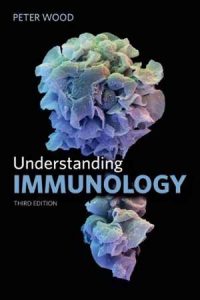نام کتاب: Understanding Immunology
نویسنده: Peter Wood
ویرایش: ۳
سال انتشار: ۲۰۱۱
کد ISBN کتاب: ۰۲۷۳۷۳۰۶۸۱, ۹۷۸۰۲۷۳۷۳۰۶۸۲,
فرمت: PDF
تعداد صفحه: ۳۶۳
حجم کتاب: ۲۱ مگابایت
کیفیت کتاب: OCR
انتشارات: Prentice Hall
Description About Book Understanding Immunology From Amazon
Understanding Immunology is a well-established introduction to this complex subject for readers with no previous exposure. It is aimed primarily at undergraduates in biological sciences, biomedical sciences and medicine. The selection and order of topic coverage is designed to instruct effectively, and a variety of boxed examples add depth and historical context for those readers wanting to go beyond the essentials. The first part of the book (Chapters 1 to 11) takes students through the pathogenesis of infectious diseases and describes the molecules, cells and tissues of the immune system that provide protection against a wide variety of pathogens. It also describes how mankind has utilised the immune system, from the development of vaccines to the production of reagents for use in the clinic and laboratory. The final four chapters describe how the immune system operates in disease situations such as allergy, autoimmunity and transplantation. This third edition is revised to cover the latest experimental and clinical changes in the subject, particularly those in the development of lymphocytes; the different types of CD4 helper T cells; the use of antibodies, including monoclonal antibodies, as experimental and clinical tools; and immunological tolerance. Dr. Peter Wood is a Lecturer in the Faculty of Life Sciences at the University of Manchester. He has over 20 years of teaching experience, both in the UK and in the USA, and is widely published in the literature. His current research interest is the role of cytokines in the development of diabetes.
درباره کتاب Understanding Immunology ترجمه شده از گوگل
شناخت ایمونولوژی مقدمه ای کاملاً ثابت برای این موضوع پیچیده برای خوانندگان است که هیچ گونه تماس قبلی ندارند. این هدف عمدتا در مقطع کارشناسی در رشته های علوم زیستی ، علوم زیست پزشکی و پزشکی است. انتخاب و ترتیب پوشش موضوعی به گونه ای طراحی شده است که به طور مtثر آموزش می دهد ، و انواع مثالهای جعبه ای عمق و زمینه تاریخی را برای خوانندگانی که می خواهند فراتر از موارد ضروری باشند اضافه می کند. قسمت اول کتاب (فصل های ۱ تا ۱۱) دانش آموزان را از طریق پاتوژنز بیماری های عفونی رهنمون می کند و مولکول ها ، سلول ها و بافت های سیستم ایمنی بدن را که در برابر طیف گسترده ای از عوامل بیماری زا محافظت می کنند ، توصیف می کند. همچنین چگونگی استفاده بشر از سیستم ایمنی بدن ، از تولید واکسن گرفته تا تولید معرف برای استفاده در کلینیک و آزمایشگاه ، توصیف شده است. چهار فصل آخر نحوه عملکرد سیستم ایمنی بدن در شرایط بیماری مانند آلرژی ، خود ایمنی و پیوند را توصیف می کند. این ویرایشسوم اصلاح شده است تا آخرین تغییرات آزمایشی و بالینی را در موضوع ، به ویژه مواردی که در توسعه لنفوسیت ها قرار دارند ، پوشش دهد. انواع مختلف سلولهای T کمکی CD4 ؛ استفاده از آنتی بادی ها ، از جمله آنتی بادی های مونوکلونال ، به عنوان ابزارهای تجربی و بالینی. و تحمل ایمنی دکتر پیتر وود مدرس دانشکده علوم زندگی در دانشگاه منچستر است. وی بیش از ۲۰ سال سابقه تدریس ، هم در انگلستان و هم در ایالات متحده آمریکا دارد و به طور گسترده در ادبیات منتشر شده است. علاقه فعلی تحقیق وی نقش سیتوکین ها در ایجاد دیابت است.
[box type=”info”]![]() جهت دسترسی به توضیحات این کتاب در Amazon اینجا کلیک کنید.
جهت دسترسی به توضیحات این کتاب در Amazon اینجا کلیک کنید.![]() در صورت خراب بودن لینک کتاب، در قسمت نظرات همین مطلب گزارش دهید.
در صورت خراب بودن لینک کتاب، در قسمت نظرات همین مطلب گزارش دهید.

